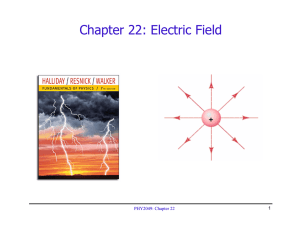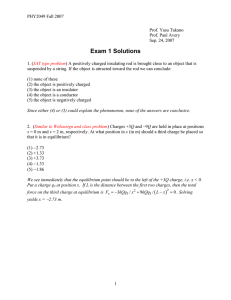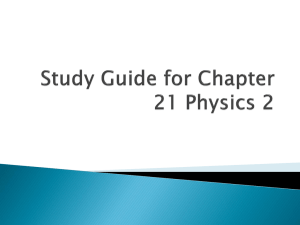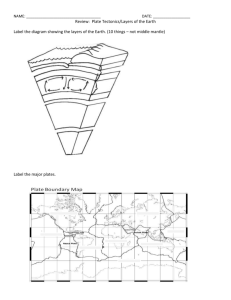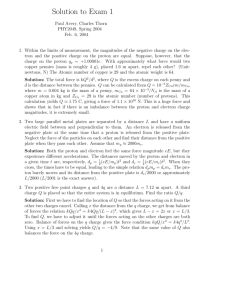Exam 1 Solutions
advertisement
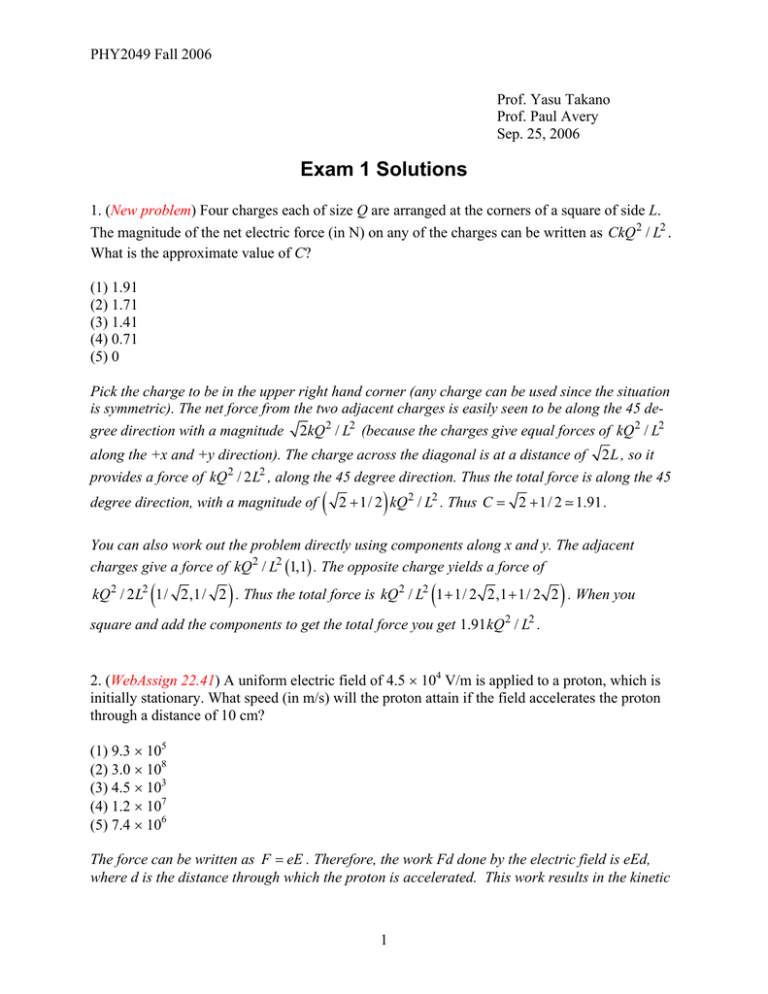
PHY2049 Fall 2006 Prof. Yasu Takano Prof. Paul Avery Sep. 25, 2006 Exam 1 Solutions 1. (New problem) Four charges each of size Q are arranged at the corners of a square of side L. The magnitude of the net electric force (in N) on any of the charges can be written as CkQ 2 / L2 . What is the approximate value of C? (1) 1.91 (2) 1.71 (3) 1.41 (4) 0.71 (5) 0 Pick the charge to be in the upper right hand corner (any charge can be used since the situation is symmetric). The net force from the two adjacent charges is easily seen to be along the 45 degree direction with a magnitude 2kQ 2 / L2 (because the charges give equal forces of kQ 2 / L2 along the +x and +y direction). The charge across the diagonal is at a distance of 2L , so it provides a force of kQ 2 / 2 L2 , along the 45 degree direction. Thus the total force is along the 45 degree direction, with a magnitude of ( ) 2 + 1/ 2 kQ 2 / L2 . Thus C = 2 + 1/ 2 1.91 . You can also work out the problem directly using components along x and y. The adjacent charges give a force of kQ 2 / L2 (1,1) . The opposite charge yields a force of ( ) ( ) kQ 2 / 2 L2 1/ 2,1/ 2 . Thus the total force is kQ 2 / L2 1 + 1/ 2 2,1 + 1/ 2 2 . When you square and add the components to get the total force you get 1.91 kQ 2 / L2 . 2. (WebAssign 22.41) A uniform electric field of 4.5 × 104 V/m is applied to a proton, which is initially stationary. What speed (in m/s) will the proton attain if the field accelerates the proton through a distance of 10 cm? (1) 9.3 × 105 (2) 3.0 × 108 (3) 4.5 × 103 (4) 1.2 × 107 (5) 7.4 × 106 The force can be written as F = eE . Therefore, the work Fd done by the electric field is eEd, where d is the distance through which the proton is accelerated. This work results in the kinetic 1 PHY2049 Fall 2006 energy of the proton increasing from zero to 1 m v2 . 2 p From eEd = 12 m p v 2 , you find v = 9.3 × 105 m/s. 3. (Lecture problem with modification) A ring of radius 2 cm has a total charge +2 × 10−9 C spread uniformly around the ring. A point charge −2 × 10−9 C is placed at the center of the ring. What is the magnitude of the electric field in V/m at a point on the central axis 4 cm from the center? (1) 3,200 (2) 11,300 (3) 8,050 (4) 2,500 (5) 0 ( The E field from a circular ring of charge is Ering = kQz / z 2 + R 2 ) 3/ 2 (as we derived in class, and you can derive here from integration around the ring), pointing upwards.This gives E z ring = 8050 V/m. The E field from the negative charge is E z point = −kQ / z 2 = −11250 V/m. The net E field from the ring charge and the point charge is therefore E z net = −3200 V/m. 4. (WebAssign 22.16) Two small charged beads are on a circular track of radius R = 2 m, as shown in the figure. Bead 1 of charge 5 μC is fixed in place; bead 2 of charge 10 μC can be moved along the track. At what value of angle θ (in degrees) should bead 2 be positioned such that the electric field at the center of the track is 3.2 × 104 V/m? y (1) 140 (2) 110 (3) 82 (4) 63 (5) 45 R θ x Let Q = 5 μC. The E field (x and y components) from charge 1 is E1 = kQ / R 2 (1, 0 ) . The E field from the second charge (charge 2Q) is E2 = 2kQ / R 2 ( − cos θ , − sin θ ) . The total field is obtained by adding components and squaring, yielding Etot = kQ / R 2 (1 − 2 cos θ )2 + ( −2sin θ )2 or Etot = kQ / R 2 5 − 4 cos θ . Since Etot is 32000, we can solve for cosθ to get θ = 140 degrees. 2 PHY2049 Fall 2006 5. (F2003 exam problem, simplified) A thick conducting spherical shell has inner radius r and outer radius R, as shown in the diagram. A point charge of −q is located at the center of the sphere and a charge of +Q is placed on the conducting shell. The charge on the inner surface of the conducting shell is: (1) +q (2) −q (3) Q + q (4) Q − q (5) Q R r −q +Q The E field in the conductor is zero. Drawing a Gaussian surface just above the inside surface, we find, by Gauss’ law, that a zero E field implies that the total enclosed charge is zero. Hence the charge on the inside surface must be +q to cancel the –q in the center. The charge on the outside surface is Q − q. 6. (New) Consider a cylinder of radius 3 m and height 10 m. At each point on the cylindrical surface, an electric field of 10 V/m points out radially. There is no electric field on the top and bottom surfaces of the cylinder. What is the charge enclosed by the cylinder in coulombs? (1) 1.7 × 10−8 (2) 2.5 × 10−8 (3) 1.1 × 10−8 (4) 9.2 × 10−9 (5) 3.4 × 10−8 We use Gauss’ law here, where only the E field perpendicular to the curved surface contributes. Using the area of a cylinder, Gauss’ law yields E ( 2π rh ) = qenc / ε 0 , where r is the cylinder radius and h is its height. Solving for the enclosed charge yields qenc = 1.7 ×10−8 C. 7. (WebAssign 24.5) Two large, parallel, conducting plates are 1.2 mm apart and have equal and opposite charges on their facing surfaces. An electrostatic force of 3 × 10−13 N acts on an electron placed anywhere between the two plates. What is the potential difference in volts between the plates? (1) 2250 (2) 360 (3) 1.88 × 106 (4) 1880 (5) 0.00044 3 PHY2049 Fall 2006 The force on an electron is F = eE. The potential difference between two plates is Ed. Thus the potential difference can be written V = Fd/e = 2250 V. 8. (Homework 24.48) Particles 1, 2 and 3 lie on a line, at positions x1 = 0, x2 = 4cm, and x3 = 10cm. The charges of particles 1 and 2 are each 5 μC. The electrical potential energy of the three-particle system is 0 (where potential energy at infinity is defined to be 0). What is the charge of particle 3 in μC? (1) −4.7 (2) 11 (3) 0 (4) −7.5 (5) −11 Let q be the charge of particles 1 and 2 and let q3 be the charge of particle 3. The total potential energy of the three particle system is U123 = kq 2 / d12 + kqq3 / d13 + kqq3 / d 23 = 0 (using obvious notation for d12, d13 and d23. This equation yields q3 = −4.7 μC. 9. (WebAssign 25.12 plus lecture discussion) In the figure shown, the battery has a potential difference of 24 V. If C1 = C4 = C5 = 5 μF and C2 = C3 = 10 μF, what is the charge on C5 in μC? (1) 80 (2) 160 (3) 120 (4) 240 (5) 40 C2 C3 C1 + V C4 C5 The total capacitance in the right hand branch is C2345 = 3.33 μF. The charge on this equivalent capacitance is the same as the charge on C5, because C5 is in series with the rest of the branch C234 (as discussed in lecture and the textbook). Thus q5 = 3.33 × 24 = 80 μC. 4 PHY2049 Fall 2006 10. (Sample problem 25-6) A parallel-plate capacitor whose capacitance is 120 pF is charged by a battery to a potential difference of 6 V between its plates. The battery is now disconnected, and a slab of a dielectric material, whose dielectric constant is 80, is slipped between the plates. What is the potential energy of the capacitor-slab device after the slab is inserted, in joules. (1) 2.7 × 10−11 (2) 5.8 × 10−7 (3) 1.5 × 10−3 (4) 0 (5) 7.4 × 103 When the slab is inserted, the electric field, and thus the potential, is reduced by a factor of 80. The capacitance is increased by a factor of 80. Thus the total energy 12 CV 2 , is reduced by a fac- ( ) tor of 80. A calculation yields U = 12 CV 2 / 80 = 12 × 120 ×10−12 62 / 80 = 2.7 × 10−11 J. 5
